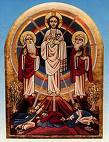St. Benedict on Lent, Part 4
This will fittingly be done if we abstain from every vice.
RB 49: 4a (my translation)
Sr. Margaret Mary Funk, OSB notes that in Evagrius and in Cassian, the 'active life' refers not to charitable works outside the monastery, but to the two-fold ascetical program of uprooting vices and planting the virtues. Vices are destructive habits, conditioned responses to situations in which we act out of fear, or self-interest. The active life, in monastic terminology, seeks to deconstruct these largely unconscious and reflexive patterns of behavior. We should therefore understand that St. Benedict is not aiming at a program of repression of 'sinful actions', and interpret this injunction through the lens of a modern Freudian model (which Alasdaire MacIntyre calls 'hydraulic' because it assumes that pressure builds up in the psyche when emotions are repressed). The way to abstain from every vice begins, yes, with a determination not to act viciously or sinfully. However, we cannot stop there. The heart is the place from which sin proceeds. If we really wish to abstain fully from vice, we must go into our hearts with the light of the gospel and illuminate the unconverted parts. Then we must give them to God. Hence the renewed emphasis on silence and prayer during Lent.
One brief final note: the word here translated as "abstain" is temperamus. This Latin term can reasonably be translated as 'abstain', but has the fuller sense of 'tempering' or 'finding the just measure'. There can be no just measure of vice, of course, but the fuller meaning of the term can help us to recognize that what is being sought is not merely a negation of impulses but a restoration of the harmonious workings of all the faculties in the inner person.

1 comment:
Regarding the reflection on "temperamus", or "finding the right measure" : this makes me think of the word "contemplative" ; in the book "Benedict's Dharma", David Steindl-Rast writes in the conclusion : "the root meaning of 'temp' is 'measure', and the temple was originally a measured-out area in th sky. The temple below was meant to be a reflecton of the perfect order above. . . To this day, contemplation remains a process that combines two
gestures : looking up to a dynamic order that transcends us and translating that order onto the level of everyday dynamics." For monastics and lay people alike, the "area" to be transformed by contemplation during Lent is our own heart.
Thank you, Prior Peter, for giving us this "lectio" of chapter 49 during Lent ; I find it very profitable !
Post a Comment